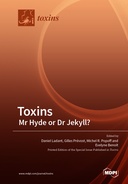Explore

Toxins
0 Ungluers have
Faved this Work
Login to Fave
Toxins are biologically active substances produced by most kinds of living organisms, bacteria, fungi, plants, and animals. They present a vast diversity of molecular structures and target a wide variety of receptors involved in a range of physiological processes. As toxins are selected during evolution to acquire/improve their disabling/lethal effects, they display finely tuned functional properties often associated with high affinities and selectivity. Moreover, toxins are valuable tools to unravel cellular processes due to their extreme specificity for cell surface and/or intracellular targets. Therefore, toxins are very attractive compounds because of their Janus-like character; while they mostly act as deadly poisons like monstrous Mr. Hyde, they can also be tamed into good remedies like admirable Dr. Jekyll. As such, they have been primarily investigated not only for the light they can throw on fundamental physiological processes but also for their potential therapeutic applications. This reprint, emerging from the 27th Annual Meeting of the French Society of Toxinology (SFET, http://sfet.asso.fr/international), will be of great interest for those in the scientific community who want to know more about the fascinating world of toxins.
This book is included in DOAB.
Why read this book? Have your say.
You must be logged in to comment.
Rights Information
Are you the author or publisher of this work? If so, you can claim it as yours by registering as an Unglue.it rights holder.Downloads
This work has been downloaded 138 times via unglue.it ebook links.
- 138 - pdf (CC BY) at Unglue.it.
Keywords
- adenylate cyclase toxin
- animal toxin
- APETx2
- ASIC
- ATP-sensitive K+ channels
- automated patch-clamp
- bacterial toxin
- Bordetella pertussis
- botulinum neurotoxin
- C3bot
- C3botE174Q
- calcium-activated K+ channels
- cAMP
- catecholamine release
- click chemistry
- clostridial C3 toxin
- Clostridium botulinum
- Clostridium tetani
- cyclic nucleotide
- Debaryomyces hansenii
- Dendritic Cells
- effector-triggered immunity
- effector-triggered trained immunity
- enterotoxin
- fetal adrenomedullary chromaffin cell
- fluorescent peptide
- gambierol
- Immunomodulation
- killer toxin
- Macrophages
- mambalgin
- marine toxin
- medical application
- Medical Toxicology
- medicine
- MitTx
- molecular and cellular targets
- Monocytes
- n/a
- native chemical ligation
- nicotinic acetylcholine receptor
- nociception
- Other branches of medicine
- Pain
- PcTx1
- PDR transporters
- peptide
- peptide chemistry
- Pharmacology
- plant toxin
- potassium currents
- Saccharomyces cerevisiae
- small RNA
- sodium channels
- spectrophotometric enzymatic assay
- staphylococcal superantigen
- stimulated emission depletion (STED)
- super-resolution microscopy
- TE671 cells
- tetanus neurotoxin
- toxin function/activity
- toxin gene regulation
- toxin pathogenicity
- toxin receptor/target
- toxin structure
- toxins
- trained immunity
- two-component system
- Wickerhamomyces anomalus
- α-bungarotoxin
Links
DOI: 10.3390/books978-3-0365-6905-5Editions

